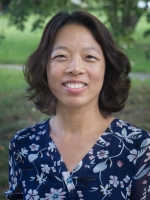
As a seismologist, I study the properties of the Earth’s crust and mantle using seismic waveforms. One major focus of my research involves “subduction zones”, the linear belts on Earth where tectonic plates converge, and one plate sinks into the mantle beneath the other plate. Earth’s largest earthquakes and volcanoes tend to occur at the convergent boundaries. My research focuses on understanding the nature of variation within and along subduction zones. The three-dimensional nature of subduction zones has been demonstrated in many geosciences sub-disciplines. To provide key new insights into the spatial and causal relationships among the various segmentation characteristics, I generate high-resolution (“tomographic”) models along the Cascadia, Aleutian/Alaska, Middle America, Caribbean, South America, and New Zealand convergent margins in a systematic and comparative way. A tomographic image is analogous to a medical CAT Scan, but using seismic waves rather than X-Rays. I am also interested in understanding the growth and evolution of continental crust through geologic time, specifically for eastern North America. Eastern North America provides a complete record of the eastward growth of the continent, from the breakup of one supercontinent (“Rodinia”), one billion years ago, through the multi-stage assembly of the supercontinent of Pangea to the formation of the modern Atlantic Ocean. To address these questions, a variety of new and powerful seismological methods, including full-wave simulation and seismic tomography, teleseismic receiver functions, and seismic anisotropy, have been developed and implemented to image the crust and upper mantle structure with high resolution. Full-wave propagation simulation within the 3D Earth structures relies on high-performance computation, which is carried out at the Massachusetts Green High-Performance Computing Center.